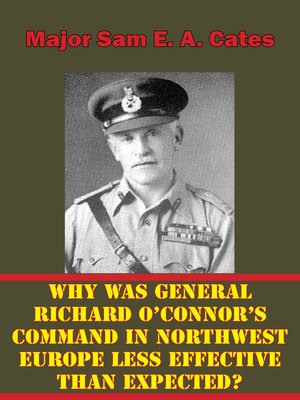Why Was General Richard O'Connor's Command in Northwest Europe Less Effective Than Expected?
ebook
By Major Sam E. A. Cates

Sign up to save your library
With an OverDrive account, you can save your favorite libraries for at-a-glance information about availability. Find out more about OverDrive accounts.
Find this title in Libby, the library reading app by OverDrive.



Search for a digital library with this title
Title found at these libraries:
| Library Name | Distance |
|---|---|
| Loading... |
General Richard O'Connor was the British VIII Corps commander in Normandy 1944. Previously he forged an outstanding reputation as a large unit commander in the desert of North Africa and this form suggests his command in Northwest Europe would be faultless. However, this was not the case. Some historians explain his pedestrian performance in Normandy by pointing to his two and a half years as a prisoner of war in Italy. This monograph challenges this narrative suggesting instead that O'Connor's command style was not suited to the context of war in Normandy. General O'Connor had a wealth of relevant military experience. The crucible of World War and his experiences commanding the Western Desert Force in North Africa created in him a style of command that was best suited to independent operations, on ground that facilitated effective maneuver, and with conditions that enable the achievement of the element of surprise. Yet in Normandy 1944, the context in which General O'Connor commanded did not allow for any of these conditions. Rather, a constrictive chain of command, narrow fronts, restrictive terrain, and the difficulty of achieving surprise all combined to provide a context in which General O'Connor was a less effective corps commander than expected.







